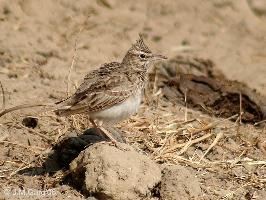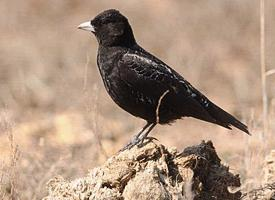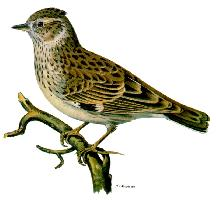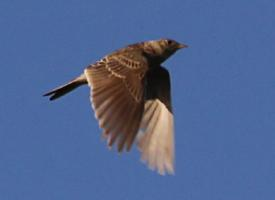
Poids et mesures
| Longueur | 17 cm |
|---|---|
| Poids | 45 g |
| Envergure des ailes | 34 cm |
Description de l'animal
The Crested Lark (Galerida cristata) is a small to medium-sized bird that is a member of the lark family, Alaudidae. It is a distinctive species, primarily known for the prominent crest of feathers on its head, which can be raised or lowered depending on the bird's mood or behavior. This crest is the most distinguishing feature of the Crested Lark, setting it apart from other lark species.Physically, the Crested Lark measures between 16 to 18 cm in length and has a wingspan of about 30 cm. It possesses a relatively stout body, with a short tail and broad wings, which are adapted for its undulating flight pattern. The plumage of the Crested Lark is predominantly a blend of brown, gray, and sandy colors, which provides excellent camouflage against the ground. Its underparts are paler, and it has a distinct, black-and-white pattern on the sides of its neck and breast, which can vary among individuals.
The Crested Lark is primarily found across Europe, the Middle East, and parts of Asia, thriving in a wide range of open habitats. These include agricultural fields, grasslands, semi-deserts, and areas of human habitation such as parks and gardens. Its adaptability to different environments is one of the reasons for its widespread distribution.
Diet-wise, the Crested Lark is omnivorous, feeding on a mix of seeds, insects, and other small invertebrates. Its feeding behavior is predominantly terrestrial; it forages on the ground, using its strong legs and beak to dig and peck for food.
Vocally, the Crested Lark is a talented singer. The males are known for their melodious and varied songs, which they often deliver in flight or from a high perch. The song is a mix of trills, whistles, and mimicry of other birds, used both to attract mates and to mark territory.
Breeding season for the Crested Lark varies depending on its range but generally occurs in the spring and summer months. The nest is a simple depression on the ground, concealed by vegetation, where the female lays 2 to 5 eggs. Both parents are involved in the upbringing of the chicks, which are altricial (born in an undeveloped state) and require extensive care before fledging.
In terms of conservation status, the Crested Lark is currently listed as Least Concern by the International Union for Conservation of Nature (IUCN), indicating that it is not currently at risk of widespread decline. However, like many bird species, it faces threats from habitat loss and degradation, primarily due to intensive agriculture and urban expansion.
Overall, the Crested Lark is a fascinating bird, not only for its distinctive appearance and beautiful song but also for its adaptability to a range of environments. Its presence across vast regions makes it a familiar sight and sound to many, embodying the diverse and rich tapestry of avian life.
Animaux similaires
Nouvelles photos d'animaux
Top 10 des animaux
- Dolphin gull (Leucophaeus scoresbii)
- Diana monkey (Cercopithecus diana)
- Moustached guenon (Cercopithecus cephus)
- Galápagos tortoise (Geochelone nigra complex)
- Russian tortoise (Testudo horsfieldii)
- Stone loach (Barbatula barbatula)
- Japanese macaque (Macaca fuscata)
- Greek tortoise (Testudo graeca)
- Common flying dragon (Draco volans)
- Vendace (Coregonus albula)


